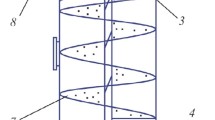Abstract
As the economical and environmental damages due to the accidental oil-spills in marine environment increase gradually, more active countermeasure needs to be developed. In this respect, in the present study, we propose a new design of oil-water separation system and investigate the effects of several geometrical features on the oil-recovery rate, based on a two-dimensional numerical simulation. The working mechanism of current separator is to utilize the density difference between the oil and water, which is strengthened by adding momentum to the oil-water mixture flow through a “U-shaped” passage. Along the flow passage, we locate additional parts such as baffle plate, weir plate, and water outlet. While optimizing the conditions of these to maximize the oil recovery, it is found that the formation and stable retention of water layer between the water outlet and weir plate is critical to separate and store the above-layered oil. Finally, these findings are further confirmed with a basic experimental test with a three-dimensional oil-water separator model.
Similar content being viewed by others
References
A. Jernelöv and O. Lindén, Ixtoc I: a case study of the world's largest oil spill, Ambio, 10 (1981) 299–306.
Z. Xue, S. Wang, L. Lin, L. Chen, M. Liu, L. Feng and L. Jiang, A novel superhydrophilic and underwater superoleophobic hydrogel-coated mesh for oil/water separation, Adv. Mater., 23 (2011) 4270–4273.
A. K. Kota, G. Kwon, W. Choi, J. M. Mabry and A. Tuteja, Hygro-responsive membranes for effective oil–water separation, Nat. Comm., 3 (2012) 1025.
T. Kim, J. S. Lee, G. Lee, D. K. Seo, Y. Baek, J. Yoon, S. M. Oh, T. J. Kang, H. H. Lee and Y. H. Kim, Autonomous graphene vessel for suctioning and storing liquid body of spilled oil, Sci. Rep., 6 (2016) 22339.
H. A. Hussein, R. Abdullah, S. Harun and M. Abdulkhaleq, Numerical model of baffle location effect on flow pattern in oil and water gravity separator tanks, World Appl. Sci. J., 26 (2013) 1351–1356.
H. A. Hussein, R. Abdullah, M. A. Ibrahim and M. A. M. Said, Experimental investigation of the effect of inlet baffle position on the flow pattern, oil concentration, and efficiency of rectangular separator tank, Desalination Water Treat., 57 (2016) 24333–24340.
M. Mostafaiyan, M. R. Saeb, A. E. Alorizi and M. Farahani, Application of evolutionary computational approach in design of horizontal three-phase gravity separators, J. Petrol. Sci. Eng., 119 (2014) 28–35.
L. Chen, S. Wu, H. Lu, K. Huang and L. Zhao, Numerical simulation and structural optimization of the inclined oil/water separator, PloS One, 10 (2015) e0124095.
J. Behin and S. Azimi, Experimental and computational analysis on influence of water level on oil-water separator efficiency, Sep. Sci. Technol., 50 (2015) 1695–1700.
M. J. H. Simmons, J. A. Wilson and B. J. Azzopardi, Interpretation of the flow characteristics of a primary oil–water separator from the residence time distribution, Chem. Eng. Res. Des., 80 (2002) 471–481.
J. Sjöblom, Emulsions and Emulsion Stability: Surfactant Science Series/61, CRC Press, 132 (2005).
ANSYS CFX-solver theory guide, ANSYS CFX Release, 11 (2012) 69–118.
M. Sato and I. Sumita, Experiments on gravitational phase separation of binary immiscible fluids, J. Fluid Mech., 591 (2007) 289–319.
Y.-J. Chen, S.-W. Chau and J.-S. Kouh, Application of two-phase fluid approach for free-surface ship flow simulation, J. Chin. Inst. Eng., 25 (2002) 179–188.
Y. M. Ahmed, Numerical simulation for the free surface flow around a complex ship hull form at different Froude numbers, Alexandria Engineering Journal, 50 (2011) 229–235.
Author information
Authors and Affiliations
Corresponding author
Additional information
Recommended by Associate Editor Sangyoup Lee
Linfeng Piao received his B.S. from Chonnam National University in 2013, and his M.S. from Seoul National University in 2015. He is currently working toward his Ph.D. at the Multiphase Flow & Flow Visualization laboratory, Department of the Mechanical & Aerospace Engineering, Seoul National University. His current research areas are oil-water separation and multiphase flow.
Nayoung Kim received her B.S. in Mechanical Engineering from Yonsei University, Korea, in 2013. She is currently working on toward her Ph.D. at the Multiphase Flow & Flow Visualization laboratory, Department of the Mechanical & Aerospace Engineering, Seoul National University. Her current research areas are oil-water separation and multiphase flow.
Hyungmin Park obtained his B.S. and Ph.D. degrees at the Department of Mechanical & Aerospace Engineering, Seoul National University, Korea, in 2000 and 2010, respectively. Dr. Park is currently an Associate Professor at the Department of Mechanical & Aerospace Engineering, Seoul National University. His research interests include multiphase flow, flow control with superhydrophobic surfaces, and fluid-structure interaction.
Rights and permissions
About this article
Cite this article
Piao, L., Kim, N. & Park, H. Effects of geometrical parameters of an oil-water separator on the oil-recovery rate. J Mech Sci Technol 31, 2829–2837 (2017). https://doi.org/10.1007/s12206-017-0526-1
Received:
Revised:
Accepted:
Published:
Issue Date:
DOI: https://doi.org/10.1007/s12206-017-0526-1




